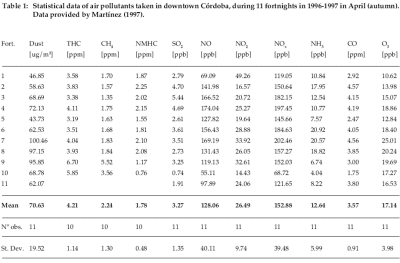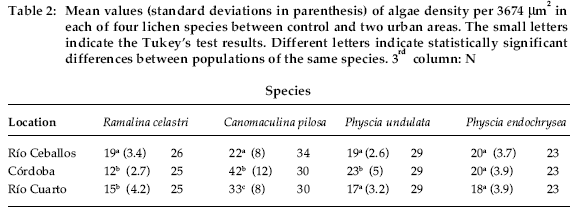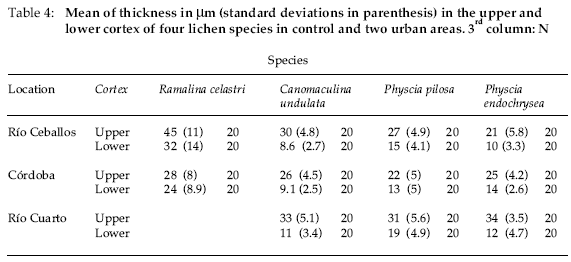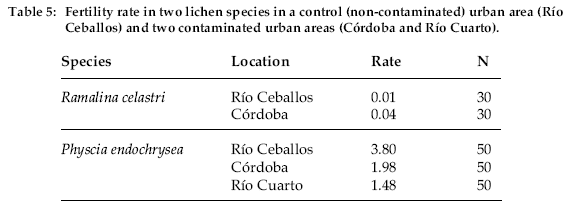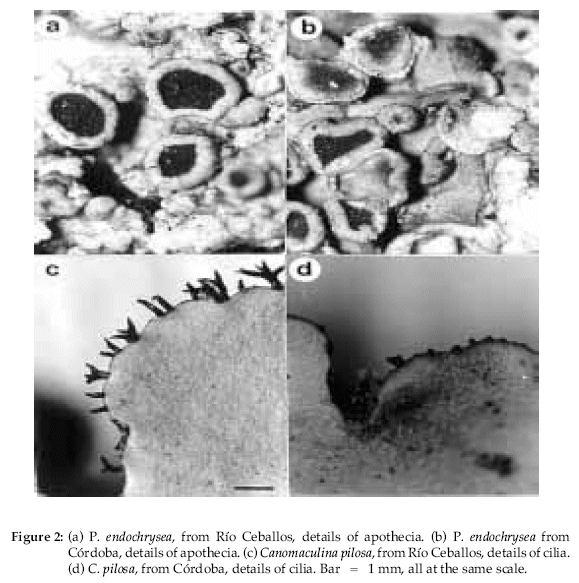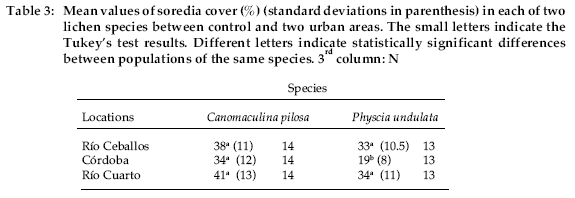Services on Demand
Journal
Article
Indicators
-
 Cited by SciELO
Cited by SciELO -
 Access statistics
Access statistics
Related links
-
 Similars in
SciELO
Similars in
SciELO  uBio
uBio
Share
Ecología en Bolivia
Print version ISSN 1605-2528On-line version ISSN 2075-5023
Ecología en Bolivia vol.39 no.2 La Paz Oct. 2004
Artículo
Effects of air pollutants on morphology and reproduction in four lichen species in Córdoba, Argentina
Efectos de contaminación del aire sobre la morfología y reproducción en cuatro especies de líquenes
Cecilia Estrabou1,2, Laura Stiefkens3, Miriam Hadid3, Juan M. Rodríguez1 & Adriana Pérez4
1Centro de Ecología y Recursos Naturales Renovables Dr. Ricardo Luti. Facultad de Ciencias Exactas, Físicas y Naturales. Universidad Nacional de Córdoba. Av. Vélez Sarsfield 299, X5000JJC, Córdoba, Argentina.
2Corresponding author. E-mail: cestrabou@hotmail.com
3Cátedra de Morfología Vegetal. Fac. Cs. Ex., Fís. y N. Universidad Nacional de Córdoba. Av. Vélez Sarsfield 299, X5000JJC, Córdoba, Argentina.
4Consejo Nacional de Investigaciones Científicas y Técnicas. Fac. Cs. Ex., Fís. y N. Universidad Nacional de Córdoba. Av. Vélez Sarsfield 299, X5000JJC, Córdoba, Argentina.
Abstract
The effects of contamination on morphological and reproductive parameters of four lichen species in two urban areas and a control site were studied. The four lichen species studied have all been previously identified as tolerant, resistant and sensitive to air pollution respectively. These species were sampled and collected from the bark of Melia azedarach L. (“paraíso”), situated in the cities of Córdoba, Río Cuarto and Río Ceballos. About 50 specimens for each species were removed. The following features were analyzed in each specimen: thallus color, cover and number of apothecia, soredia, necrosis of the thallus, changes in thallus size, thickness of lower and upper cortex, algae number and a fertility index was built.
In Ramalina celastri, a sensitive species, darkening and reduction of thallus size, the presence of particulate matter and necrotic areas are some of the visible effects of air pollution. Physcia endochrysea, a resistant species, only shows minor changes in polluted areas. In resistant species, the fertility rate shows a marked reduction in polluted areas. In Canomaculina pilosa, a tolerant species, a reduction in thallus size and darkening of both the thallus and soredia is evident. Necrotic areas are particularly obvious with this species as well. Physcia undulata exhibits the fewest alterations and greatest growth in urban areas. The most variable feature was the thickness in the upper and the lower cortex. Algae number measured in lacunae along with he fertility index resulted good indicators.
Key words: bioindicators, air quality, lichenized fungi.
Resumen
Se estudiaron los efectos de la contaminación sobre los parámetros reproductivos y morfológicos de cuatro especies liquénicas en dos áreas urbanas y un sitio control. Las cuatro especies liquénicas estudiadas fueron previamente identificadas como resistente, tolerante y sensible a la contaminación, respectivamente. Las especies fueron censadas y colectadas sobre corteza de Melia azedarach L. (“paraíso”), situados en las ciudades de Córdoba, Río Cuarto y Río Ceballos. Alrededor de 50 ejemplares fueron removidos para cada especie. Los siguientes caracteres fueron analizados en cada ejemplar: color del talo, cobertura y número de apotecios, soredios, necrosis del talo, cambios en el tamaño del talo, espesor de corteza superior e inferior, número de algas y se generó un índice de fertilidad.
En Ramalina celastri, especie sensible, la disminución del talo hasta la mitad de lo normal, su oscurecimiento, la presencia de material particulado y áreas necrosadas son algunos de los efectos más visibles de la contaminación. Physcia endochrysea, una especie resistente, presentó sólo pequeños cambios en áreas contaminadas. En especies resistentes la tasa de fertilidad muestra una marcada reducción en áreas contaminadas. En Canomaculina pilosa, una especie tolerante, se ve una reducción del talo y oscurecimiento del mismo y de los soredios. Asimismo se destacan áreas necróticas.
Physcia undulata es la especie resistente con menores cambios y mayor desarrollo en áreas urbanas. El espesor de corteza superior e inferior es el carácter más variable. El índice de fertilidad resultó un buen indicador al igual que el número de algas que se refleja en espacios lacunares.
Palabras clave: bioindicadores, calidad del aire, hongos liquenizados.
Introduction
Previous studies have shown the sensitivity of epiphytic lichens (Richardson 1988). One definition for sensitivity by Dobben & Braak (1999): the decrease in abundance of a species with increasing pollutant concentration.
Responses of lichens to air pollution include a decrease in species numbers (Follmann 1973), species coverage (Barkman 1958), and reproduction changes by the reduction in size and numbers of apothecia and vegetative reproductive structures both in size and in number (LeBlanc & De Sloover 1970).
Additionally, changes in lichen form, color and structure become evident (Le Blanc & Rao 1973). A decrease in respiration and photosynthesis (Wirth & Turk 1975) are another response. In Argentina, a list of urban epiphytic lichens for Buenos Aires City is documented by Scutari & Theinhardt (2001). Recent research on air pollution and lichens is reviewed in the recent book edited by Nimis et al. (2002).
The aim of this study was to explore the effects of air pollution on lichen species in the city of Córdoba, Argentina, in terms of their reproductive and morphological parameters. These parameters include changes to apothecia and soredia, change in thallus size and necrosis of the thallus. In addition, changes in cortex thickness, algae quantity, and lacunae in tissues were looked at the four species studied Canomaculina pilosa (Stizemb.) Elix & Hale (Parmeliaceae), Physcia undulata Moberg, Physcia endochrysea Krempelh. (cf. Scutari 1995) (Physciaceae), and Ramalina celastri (Sprengel) Krog et Swinscow (Ramalinaceae) all lichenized Ascomycotina. These species have been assessed to be sensitive, tolerant and resistant to air pollution by Estrabou (1998). The species selected for this study are the only lichens found growing in the urban areas under study.
Study areas
The four lichen species studied have all been previously identified as tolerant, resistant and sensitive to air pollution. These species were collected from the bark of Melia azedarach L. (“paraíso”), situated in the cities of Córdoba,Río Cuarto and Río Ceballos. Córdoba city (population of 1.200.000 in the 1991 census) is located in the center of the Argentine Republic, 31° 24’ S, 64° 11’ W. The city is at 440 m and has an irregular topography. The climate is subhumid, with an average annual precipitation of 790 mm, concentrated principally in the summer. Mean annual temperature is 17.4 °C and prevailing winds come from the northern and southern directions. Emissions of air pollutants increased by 50% between 1973 and 1983, reaching 287 metric tons of total pollutants/day. Córdoba is one of the most polluted cities in the country (Cañas et al. 1997; Table 1). Río Ceballos (the control site) is a small village on the hills of Sierras Chicas, at 31° 10’ S, 64° 20’ W, 36 km away from Córdoba city, with an mean annual temperature of 13°C, and an average annual precipitation of 779 mm. Nearby hills are covered by an open forest (Vázquez et al. 1979). Río Cuarto is an industrial city with 137,000 inhabitants (Geimonat 1996) and show moderated level of pollution. Located 300 km away to the south-east from Córdoba city, with an average annual precipitation of 800 mm.
Methods
Five wayside trees selected from downtown to northwest were sampled in each place. Trees were selected taking the first five ones on the right side of the street. On each selected tree, at 1.5 meters from the base, one 30 x 30 cm2 (Estrabou 1998) was used to assess presence and coverage of each species. All specimens of the four species present were taken from each square (usually around 10).
For each sample, (about 50 specimens for P. undulate and P. endochrysea and about 30 for C. pilosa and R. celastri) the following features were analyzed using an Olympus VM stereomicroscope: thallus color, presence of apothecia, soredia, necrosis of the thallus, and changes in thallus size and other external features (e.g., insect eaten areas, lobe size, branching).
The following formula was designed to calculate the fertility rate (F)

Where n = total number of spores, N = number of apothecia (in a 25 mm2 thallus square), and C = proportion of apothecia covering the square.
The total number of apothecia present in a 25 mm2 section of a thallus was counted and their coverage in percentage was estimated using a 25 mm2 grid. To determine the number of apothecial spores, an apothecium of about 1.15 mm diameter was selected from each sample, chopped up on a slide and macerated in a drop of distilled water. Fifty µl of this suspension was removed with an automatic pipette and placed in a Neubauer counting chamber. The number of spores present in each slot was then counted.
To analyze the cortex thickness and algae density, transverse sections were made from a small piece of lichen thallus and fixed in FAA (mixture of formaldehyde, ethanol and acetic acid). The samples were dehydrated in an ethanol series of increasing strength and left in butanol overnight. Later, they were cleared in two changes of xylol and included in “paramat” Sections 10 to 15 µm thickness were cut with a Minot rotary microtome. Hematoxylin was used as a stain and the slides were set with Canada Balsam. The resulting transverse sections were then analyzed using a Bausch & Lomb RD microscope: lower and upper cortex thickness, algae quantity present in a 3.674 µm2 area in the medulla, lacunae in tissues and presence of epinecral tissues.
Photographs of thalli, soredia, apothecia and other structures were taken using a Leica stereoscopic lens, Wild Apozoom 400076 and Zeiss photomicroscope.
The algae numbers per µm2 were compared statistically using SPSS (release 6.0 ) between the three study sites. This program was also used to determine the soredial cover from the three study sites. Analysis of variance was carried out in order to determine significant differences (Scheffé, 1959; Sokal & Rohlf 1981). Comparisons of means were carried out using Tukey’s HSD test.
Results
Table 1 shows data of air pollutants taken in downtown Córdoba, during 11 fortnights in April (autumn) provided by Sistema de Monitoreo del Aire de la Ciudad de Córdoba and analyzed by Martínez (1997). Data are compatible with values proposed by the Environmental Protection Agency. The statistical analysis was carried out using the means values for each variable and per hour.
Ramalina celastri
In the control area the specimens showed a normal condition. The average density of algae was greater in the control area than in the polluted areas (Table 2) (Figure 1a).
The upper cortex thickness showed a mean of 45 µm (Table 4) in the control area.
Pseudocyphellae were absent while numerous pedicellate apothecia occur on older thalli, up to 0.1 cm in diameter. Apothecia present had white convex discs, and straight ascospores (10-16 x 4-7 µm). The fertility rate was 0.01 (Table 5).
In Córdoba City, the thalli were no more than 2 to 3 cm long. The green color was darker in parts of the thallus, with extensive areas even darker (gray or black) close to the point of attachment. These changes in color were observed to be from the deposition of particulate matter as well as from small areas of necrosis.
The ramifications branch off close to the base and are generally narrow up to 0.5 cm wide with numerous secondary small branches, and the ribs along the ramifications were quite noticeable. The medulla had more lacunae than those found in the control rural area (Figure 1b). In addition, the algal layer was attached to the upper cortex giving the appearance of epinecral tissue. This diminished the number of algae per mm2. The upper surface was thicker compared to the control area, a mean of 28.5 µm, the lower cortex presented a less variation (Table 4). Thallus edges had evidence of insect damage and the apothecia were partly necrotic, eaten by insects or empty. The number of apothecia per unit area was greater than in the control area but the number of spores decreased. There were deposits of particulate matter on the discs. The fertility rate increased to 0.04 (Table 5) in the urban areas.
In the city of Río Cuarto, no samples with this species were found, but samples collected in outlying areas were similar in structure to those in the control area.
Physcia endochrysea
It is absent both in Río Cuarto city and downtown areas of Córdoba where pollution indexes are higher. It appears about 1.5 km from downtown on the trunks of wayside trees.
In the control area, thalli of this species ranged from 2 to 4 cm in diameter, orbicular with a glaucous-greenish color. The upper surface was plain or farinose, epruinous with imbricate lobes and rounded points. There was no epinecral layer on the upper cortex. The upper cortex thickness presented a mean of 21.4 µm and the lower one of 10 µm (Table 4). This species has a white medulla with patches of darker colors. The average alga quantity per mm2 did not vary between the three sites (Table 2), and there were no lacunae present (figure 1c). The numerous apothecia are laminar, sessile, black with plain discs (figure 2a). The ascospores are brown, 1-septate. The fertility rate was 1.48 for the Río Ceballos site (Table 5).
In the city of Córdoba the thalli were greenish-gray to mineral gray, tightly attached to the substrate becoming difficult to distinguish on the trunk. The lobes were rarely imbricate, tightened to the substrate with barely defined edges. Eaten or necrosed apothecia (figure 2b) were observed, the fertility rate was lower in Córdoba compared to the control rural area (Table 5). Lacunae (figure 2d) and reduced epinecral tissues (figure 1e) were observed. The mean of the upper cortex thickness was 25 µm whereas the lower one was slightly thinner (Table 4).
In the city of Río Cuarto the thalli were greenish-gray with well-defined edges. A less differentiated epinecral tissue was observed. Well-developed apothecia were observed, but were folded so that the epithecium was hidden. Deposits of particulate material were observed as well. The fertility rate decreased to 1.48 (Table 5). In many cases the apothecial surface was covered with deposited material and soot and the upper cortex was thicker than Córdoba and control site while the lower cortex did not change (Table 4).
Canomaculina pilosa
This species is common in Córdoba City (Estrabou 1999), but the urban area thalli exhibit morphological changes and a decreased cover. According to Estrabou (1998) it is tolerant to pollution.
In the control area, this foliose species has thalli up to 15 cm diameter, greenish-gray or mineral gray, tightly attached to the substrate, apically rounded sub-irregular lobes, strong, plain or branched, with crenate edges (figure 2c), densely ciliate with short cilia ranging 0.2 – 1.5 mm. Lacunae were not observed in the medulla. Algae numbers (Table 2) were greater in the two polluted areas than in the control rural area (figure 3 a, b). The upper surface is white-spotted and plain. The upper and the lower cortex did not vary between the three sites (Table 4). The lower surface was black with simple and branched rhizinae. Orbicular soralia were dispersed and coalescent at maturity. Apothecia and pycnidia were not observed. The soredial cover of this species did not vary at the three sites (Table 3).
In Córdoba City, thallus size decreased considerably, rarely reaching 5 cm in diameter. The thallus color is darker, with soot observed on the upper surface and on the soredia. Frequently, necrosed soredia were noticed as well. The thallus had no insect damage, but the soredia did. In spite of this, there were no variations in soredial cover (Table 3). Cilia were drastically reduced in size (figure 2d). Wide lacunae were present between the medulla and the upper cortex but the upper and the lower cortices did not show thickness changes. The average number of algae was the greatest in the urban site (Table 2).
In Río Cuarto City, the thalli examined had darker centers, 5 to 7 cm in diameter with frequent peripheral necrosis. Darkening was due to the deposition of particulate matter. The necrosis appeared first on the ridges where the surface was more exposed and extended over the whole thallus later. Although the soredia were not necrosed, they were eaten by insects.
Their substrate coverage was higher than at Córdoba and Río Ceballos. As in Cordoba, the cilia size was considerably reduced but the lacunae in the medulla were fewer than in Córdoba. The upper and the lower cortex were compared to the other sites but the difference was not significant (Table 4).
Physcia undulata
This species is frequent in Córdoba City but is rare in rural areas. Being a nitrophilous species, it inhabits road-side tree trunks in areas of heavy traffic. The thallus is up to 4 cm diameter, irregular to orbicular and loosely attached, mineral gray with deposits of white crystals giving it a “frosted” appearance (cf. Moberg 1968). The lobes are up to 2 mm wide, rounded with abundant marginal soralia giving the thallus an appearance of uneven edges. The soredial cover in Río Ceballos and Río Cuarto was similar but lower than in Córdoba (Table 3). Apothecia were not seen. The quantity of algae (Table 2) was greater in Córdoba City than at the other two sites. The lower cortex thickness was similar at all sites (Table 4). In Córdoba City there was no reduction in thallus size but the color appeared darker, even though no soot deposit was observed. Insect eaten thalli and soredia were often observed. There were fewer soredia present than at the other two sites (Table 3), the quantity of algae was smaller (Table 2) and the upper cortex thickness was reduced (Table 4).
At the urban sites in Río Cuarto City as in Cordoba, there were few morphological changes but some soot deposits were observed. Soredia were also covered with particulate matter and were considerably darker. Larger lacunae were observed in Río Cuarto than in Córdoba City.
Discussion and conclusions
In the urban areas of Cordoba there is a low lichen diversity but a variable reproductive capacity, especially in the few toxitolerant or resistant species. In extreme environmental conditions, such as the Gobi Desert, there is an increase in the number of apothecia, but the number of spores is often reduced (Gorbushina et al., 2000). In the present study, a reduction in the number of apothecia and coverage and the same number of spores was observed in the pollution sensitive species Ramalina celastri, whereas in urban areas, resistant species like Physcia increased the number of apothecia and coverage and decreased the number of spores.
Vegetative structures respond in various ways to air pollution (Déruelle 1978). Mykhaylova (2000) explained the response of lichens to stress factors in terms of slower growth rates with no or reduced soralia. In the present study, the pollution tolerant species showed no change in the cover of soredia, whereas the resistant species exhibited a decrease in Córdoba city like in P. undulata. Déruelle (1978) summarizes macroscopic changes in lichen thalli in response to pollution as a decrease in thallus size, presence of soot, necrosed areas and changes in form. It is clear that not all lichens respond in the same way and that further investigations are warranted.
The cortex thickness did not present a clear pattern in this study. The variations found need further study to interpret them in relation to air pollution. Some species showed a thicker upper cortex in urban areas (P. endochrysea), other in control site (R. celastri) while C. pilosa and P. undulata were variable. In the sensitive species R. celastri, there were more algae per unit area in the rural area and fewer in the polluted ones. González & Pignata (1999) demonstrates that the phaeophytin/a to chlorophyll/a ratio in Ramalina ecklonii (Sprengel) G. Meyer & Flotow (this species is a synonym of R. celastri) increases near industrial plants in the city of Córdoba, which decreases the number of algae.
In the tolerant species, C. pilosa, there was an increase in algal density in Cordoba City. The resistant species P. endochrysea showed very little change and P. undulata showed a reduction in algal quantity in Córdoba. It is probably due to the effects of SO2 over the phaeophytin/a – chlorophyll/a ratio and as well the algal destruction. The deposition of particulate and soot probably decrease the photosynthesis ratio and inhibit normal thalli development.
Acknowledgements
To Mr. D. Reynoso for expert technical help and to the Secretary of Science and Technology of University of Córdoba for financial support.
References
Barkman, J. J. 1958. Phytosociology and ecology of cryptogramic epiphytes. Van Gorcum, Assen. 628 p.
[ Links ]Cañas, M., Orellana, L. & M. L. Pignata. 1997. Chemical response of the lichens Parmotrema austrosinense and P. conferendum transplanted to urban and non-polluted environments. Annales Botanici Fennici 34: 27-34.
Déruelle, S. 1978. Les lichen et la pollution atmosphérique. Bulletin D´Écologie, 9 (2): 87-128.
[ Links ]Dobben, H. F.& C. J. F. ter Braak. 1999. Ranking of lichen sensitivity to air pollution using survey data: a comparision of indicator scales. Lichenologist 31 (1): 27-39.
Estrabou, C. 1998. Lichen species identification and distribution according tolerance to airborne contamination in the city of Córdoba, Argentina, pp. 165-169. En:M.P. Marcelli & M.R.D. Seaward (eds.). Lichenology in Latin America: History, Current Knowledge and Applications. M. R. D. CETESB, Sao Paulo.
[ Links ]Estrabou, C. 1999. La familia Parmeliaceae (Ascomycetes liquenizados) sensu stricto de la provincia de Córdoba: estudio sistemático-biogeográfico”. Ph. D. Thesis, Fac. Cs. Ex., Fís. y Naturales. Universidad Nacional de Córdoba, Argentina. 185 p.
Follmann, G. 1973. Über den Rückgang der Flechtenflora in Stadtgebiet von Kassel (Nordhessen, Bundesrepublik, Deutschland). Philippia 1: 241-257.
[ Links ]Geimonat, A. F. 1996. La región del Sur Cordobés. Reflexiones para su desarrollo. Universidad Nacional de Río Cuarto. Córdoba. 94 p.
[ Links ]González, C. M. & M. L. Pignata. 1999. Effects of pollutants emitted by different urbanindustrial sources on the chemical response of the transplanted Ramalina ecklonii (Spreng.) Mey & Flot. Toxicological Environmental Chemistry 69: 61-73.
Gorbushina, A. A; M. Galun & N. S. Golubkave. 2000. Symbiotic (lichenised) and free living fungi on desert rocks: propagation strategies and similarity of vegetative life forms. 4th IAL Symposium. Progress and problems in lichenology at the turn of the millenium. Barcelona. 98 p.
[ Links ]LeBlanc, F. & J. De Sloover. 1970. Relation between industrialization and the distribution and growth of epiphytic lichens and mosses in Montreal. Canadian Journal of Botany 48: 14851469.
LeBlanc, F. & D. N. Rao. 1973. Effects of sulphur dioxide on lichens and mosses transplants. Ecology 54: 612-617.
Martínez, G. 1997. Respuesta química de una especie liquénica a contaminantes atmosféricos y variables ambientales registradas por el S.I.M.A. Municipalidad de Córdoba. Tesis para optar el título de Biólogo. Departamento de Química. Facultad de Ciencias Exactas, Físicas yNaturales. Universidad Nacional de Córdoba. 120 p.
[ Links ]Moberg, R. 1968. The genus Physcia in East Africa. Nord. J. Bot. 6: 843-864.
[ Links ]Mykhaylova, I. 2000. Populations of Hypogymnia physodes (L.) Nyl. under the stress conditions their structure and functioning. 4thIAL Symposium. Progress and problems in lichenology at the turn of the millenium. Barcelona. 98 p.
[ Links ]Nimis, P. L, C. Scheidegger & P. A. Wolseley. 2002. Monitoring with lichens -Monitoring lichens. (Nato Science Series. IV. Earth and Environmental Sciences Vol. 7). Kluwer Academic Publishers, Dordrecht, Boston, Londres. 408 p.
[ Links ]Richardson, D. H. S. 1988. Understanding the pollution sensitivity of lichens. Bot. J. Linn. Society. 96: 31-43.
[ Links ]Scheffé, H. 1959. The analysis of variance. John Wiley, Nueva York. 210 p.
[ Links ]Scutari, N. C. 1995. Los macrolíquenes de Buenos Aires, I: Dirinaria, Heterodermia e Hyperphyscia (Physciaceae,Ascomicotina). Darwiniana. 33 (1-4): 149-176.
[ Links ]Scutari, N. C. & N. I. Theinhardt. 2001. Identification of urban lichens in the field: a case study for Buenos Aires City (Argentina). Mycotaxon 80: 427-445.
[ Links ]Sokal, R.R. & F. J. Rohlf. 1981. The principles and practice of statistics in biological research. Freeman, San Francisco. 832 p.
[ Links ]Vázquez, J., R. Miatello & M. Roqué 1979. Geografía física de la provincia de Córdoba. Ed. Boldt. Buenos Aires. 368 p.
[ Links ]Wirth, V. & R. Turk. 1975. Zur SO2 Resistenz von Flechten verschiedener Wuchsform. Flora 164: 133-143.
Artículo recibido en: Septiembre de 2003.
Manejado por: Renate Seidel
Aceptado en: Octubre de 2004.













